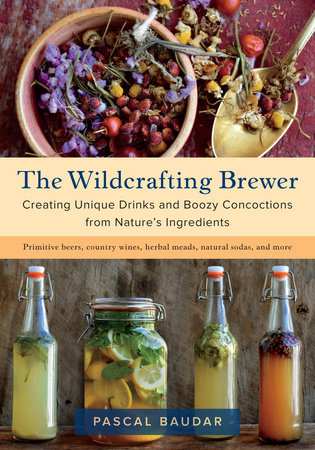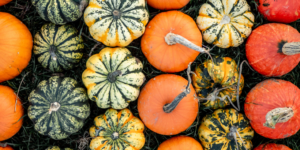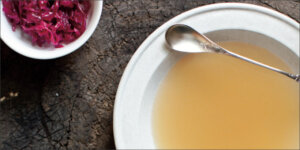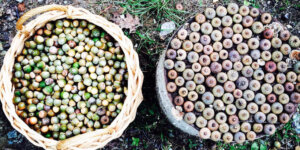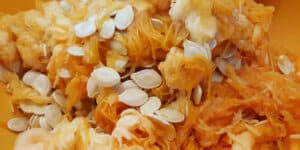Fermentation Sensation: Turmeric Mead
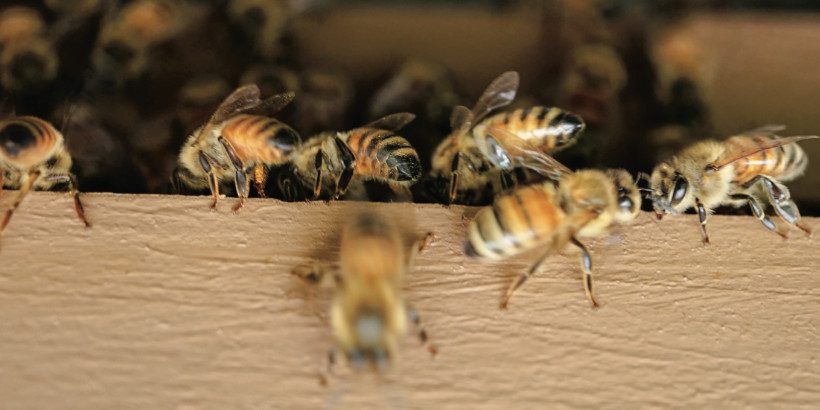
Fermented honey, or mead, is widely thought to be the first intentional ferment. Honey is rarely fermented alone, although it can be. Typically, meads include botanical enhancements. Mead is a perfect way to share the flavors, aromas, and other powers of plants. Meads are also enriched by the additional yeasts and often complementary nutrients that the plants contribute.
In this recipe, Sandor Katz uses turmeric to enhance his mead recipe, with an addition of black peppercorns to balance turmeric’s anti-inflammatory compound.
The following is an excerpt from Sandor Katz’s Fermentation Journeys by Sandor Ellix Katz. It has been adapted for the web.
I just learned a couple of years ago that I can grow turmeric where I live. It is a beautiful plant; in a single growing season each plant produces an impressive mass of rhizomes, and with heavy mulching, the rhizomes can overwinter. And I love turmeric mead. It has a beautiful, balanced flavor and a lovely warm color. I add a little black pepper, too—a subtle flavor accent that is also said to increase our ability to absorb curcumin, turmeric’s anti-inflammatory compound.
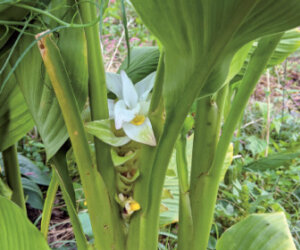
Flowering turmeric plant
Typically, I ferment mead for at least a full year before bottling. Six months in the original vessel, then six months more after it has been strained and siphoned into another. You can certainly enjoy it much sooner than this, any time after about a month. But if you decide to drink it young and sweet, don’t try to bottle it for long-term storage. For long-term bottling and aging, be quite certain that the fermentation is complete.
Turmeric Mead
Timeframe
1 month for a very sweet, young mead; 1 year for a dry mead that can be aged.
Equipment
- 1-quart/1-liter (or larger) ceramic crock or wide-mouth jar
- 1-gallon/4-liter glass jug (the kind you can buy apple juice in)
- Airlock and carboy bung (from beer and wine supply shop for a few dollars; these are helpful but not necessary)
- Bottles and corks, or other sealing tops, of any size, totaling
- 1 gallon/4 liters (if you wish to age mead past fermentation)
Ingredients
for 1 gallon/4 liters
- About 8 ounces/250 grams turmeric rhizomes
- 1 to 2 tablespoons black peppercorns (optional)
- 3 cups/1 kilogram honey (raw if available)
Process
Cover turmeric rhizomes with water. Rub them vigorously with a brush or your hands to remove loose skins, then rinse.
Slice the turmeric rhizomes crosswise into thin slices, then place them in the smaller, wide-mouth fermentation vessel. Add the black peppercorns if desired.
Mix the honey with the turmeric and stir. You could go ahead and add water at this stage, as directed in the next step, but I like to infuse the turmeric in honey first. The little bit of juice that the honey pulls from the turmeric is enough to start fermentation. I like to stir or shake the turmeric-honey mixture once a day for a couple of weeks, until it’s nice and bubbly.
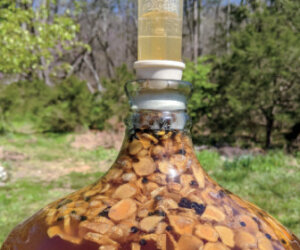
Turmeric mead fermenting
Once the turmeric-infused honey is good and bubbly, transfer it to the jug. Have a little more than 3 quarts/3 liters of dechlorinated water on hand to add. Pour a cup or so of the water into the original vessel and shake it to get all the honey residue from the edges, then add it to the jug. Add another quart/liter of the water to the jug and shake to dissolve the honey. Finally, fill the jug with dechlorinated water to the point where the neck narrows, leaving just about 2 inches/5 centimeters of air space in the neck of the bottle. Mix well, until the honey is thoroughly dissolved.
Cork with an airlock if you can, or improvise with a balloon, condom, or any jar lid that can rest on it loosely and slow airflow without holding pressure in.
Ferment for several months, until all signs of bubbling stop. You can enjoy it now, though it will still be quite sweet and relatively low-alcohol. Or you can continue to ferment it.
Strain out the turmeric slices and enjoy them as a tasty snack or cooking ingredient.
Drink it now, or bottle and store in the fridge or in bottles that get off-gassed; bottling for aging at this stage is typically premature and can result in popped corks or explosions.
If you wish to continue fermenting, siphon the strained mead back into the jug. Siphoning aerates the liquid and gets a “stuck” fermentation unstuck. You’ll lose some volume from the turmeric and lees left behind during the siphoning. Top it off with honey water as needed, adding about 4 tablespoons of honey for each 1 cup/250 milliliters of water. Cork again with an airlock if you can, or improvise. Ferment for several more months, until all signs of bubbling stop. Siphon fully fermented mead into bottles to age.
Recommended Reads
Recent Articles
Pumpkins: Halloween symbol or sweet treat? But have you ever wondered how they became a holiday staple? Discover the rich history behind this fall favorite!
Read MoreYou’ve Been Missing Out! Bone Broth is the ultimate superfood, packed with nutrients and goodness. Consider adding this nutrient-rich, immune system boosting bone broth into your daily diet.
Read MoreCIDER LOVERS ALERT! 🍎 Did you know the type of apple used can make or break the flavor? Which apple variety do you think makes the best cider?
Read MoreThese small fruits are a delicious source of nutrients that you can find almost anywhere. Get started on acorn harvesting with help from these simple tips!
Read MoreWondering what to do with pumpkin seeds? Instead of roasting them, try these alternative ways to prepare & use seeds! Plus a must-try pumpkin granola recipe.
Read More


